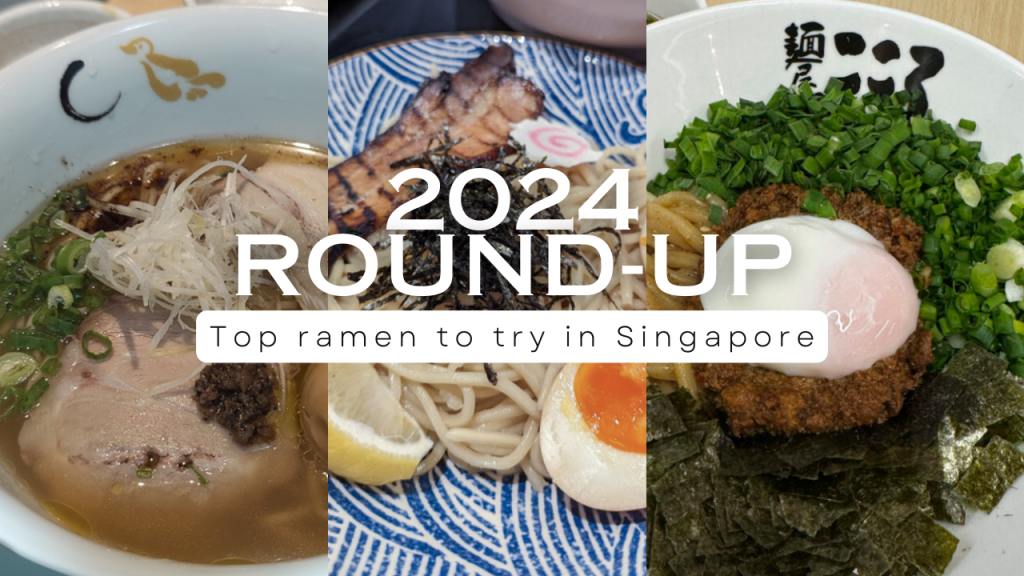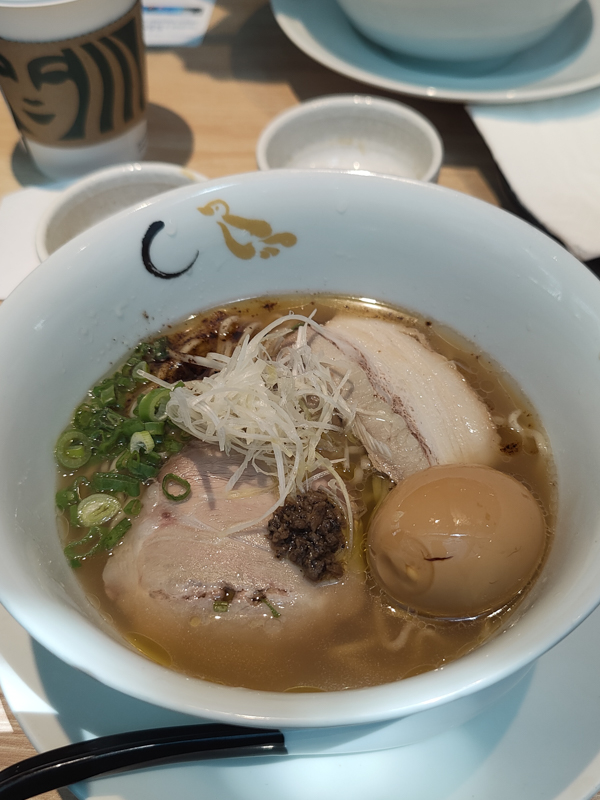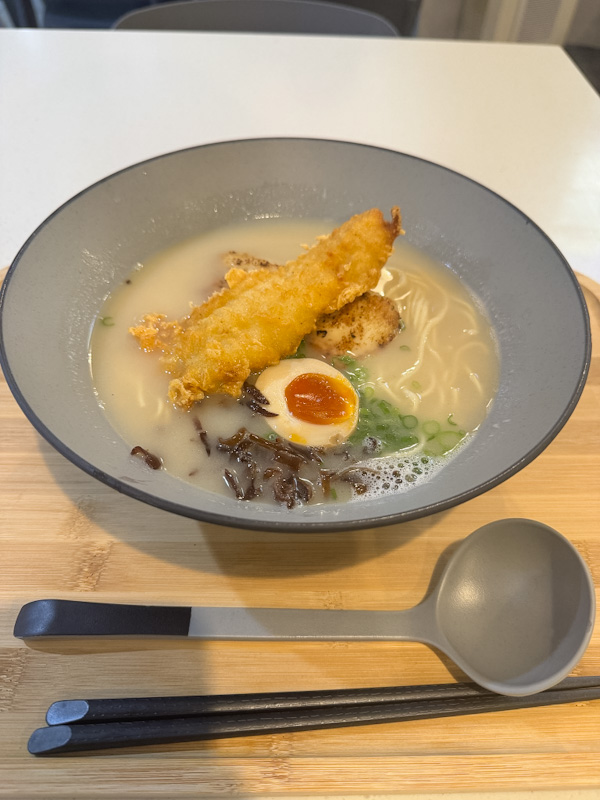
Update: a newer 2025 version of my guide is now available here.
Singapore’s ramen scene just keeps getting better every year. We’re seeing more big names popping up, like Mashi no Mashi and Mensho Tokyo joining the mix recently.
Last year, I shared my best ramen spots in Singapore in my 2023 roundup. This time around, I’m going to dive into the different types of ramen you can find here and what’s definitely worth a try.
TONKOTSU
Let’s start with the familiar tonkotsu. It’s supposed to be thick, rich, and super porky—though I’ll admit, some of the most authentic versions I’ve had in both Singapore and Japan can be a bit much for some people. But here are two modern takes that I think really hit the spot for the Singaporean palate.

Ippudo – Bonito Tonkotsu
What I love about this Bonito Tonkotsu Ramen is how it blends two bold flavors into a rich, complex broth. You get the punch of bonito, the creamy depth of tonkotsu, and a refreshing zing from the citrus pepper paste, all working together seamlessly. The al dente noodles soak up every bit of that flavorful broth, and the juicy, savory-sweet charshu adds an extra layer of satisfaction. While the toppings are pretty standard, the standout broth and tender meat leave a lasting impression.

Keisuke Tonkotsu King Four Seasons – Tonkotsu King Ramen
Another one worth mentioning is Keisuke Four Seasons. If you’re familiar with their menu, they offer ramen in four distinct variants inspired by the seasons. But there’s one standout dish called Tonkotsu King Ramen. It’s similar to the usual tonkotsu but with a twist—swapping the traditional chashu for yakiniku-style ginger pork, which gives it a nice, tangy kick. This change helps solve the biggest flaw in many tonkotsu ramens: the overly rich, “jelak” feeling that can make it feel flat and heavy. With plenty of garnishes and their popular marinated beansprouts, this dish is hearty, flavorful, and satisfying.
SHOYU
It’s been a while since popular Shoyu ramen brands like Tsuta arrived in Singapore, but honestly, the quality of Shoyu ramen here is still not on par with what you’d find in most shops in Japan. That said, there are a few places that do a decent job and are worth trying.

Konjiki Hototogisu – Shoyu Hamaguri Soup Ramen
They’ve been around in Singapore for quite some time, and after trying various outlets, I found the Chijmes location to be noticeably better. The Shoyu Hamaguri Clam ramen has a delicious umami flavor for clam lovers, featuring a lovely blend of earthy notes and a subtle tanginess from quality shoyu. The broth offers a nice mix of clam and shoyu, with umami notes and a hint of porcini oil, although it could use a bit more complexity. The toppings included decent pork belly, but the standout was the tender sous vide chashu, which had a sweet and savory marination. While the overall dish was satisfying, more creative toppings could have enhanced the experience even further.

Menbaka – 226 Years Shoyu Ramen
Another decent Shoyu ramen is the 226 Years Shoyu Ramen from Menbaka. True to their identity, this ramen is packed with that signature “wok hey” flavor, while the quality shoyu adds a nice tangy undertone that complements the dish. The soup starts with the sweetness of tonkotsu broth, smoothly transitioning into a robust shoyu aftertaste, enhanced by that lingering “wok hey” flavor, which gives it a distinctive character. Topped with generous portions of lean yet tender meat that practically crumbles at the touch, this ramen is a solid option overall.
SHIO
A good shio ramen is really hard to come by because it’s so light that even a minor flaw can throw off the balance of the meal. Unfortunately, I haven’t found any decent “real” shio ramen in Singapore, so these aren’t your typical clear and light shio ramens. Hopefully, someone can point me to a good one in Singapore one day.

Santouka, Creamy Shio Ramen
Santouka’s signature is the creamy shio, which, to be honest, feels more like shio in name, but it’s still a really delicious dish. The soup stands out as a creamy rendition that strikes a perfect balance between savory and sweet, making it rich yet refreshingly satisfying. Each sip is complemented by the fragrant nuttiness of sesame seeds, enhancing the overall wholesomeness of the dish. Santouka also sets itself apart with generous portions of chashu, featuring thick, succulent cuts that meat lovers will adore. The tender texture of the meat yields effortlessly with each bite, and its well-executed marinade hits the perfect balance of saltiness without overpowering the other flavors.
MISO
For miso ramen, it’s a slightly different story compared to shio ramen. It’s one of the most commonly found ramen variants in Singapore, yet it’s still really hard to come across one that’s truly exceptional.

Santouka – Miso Ramen
Another mention of Santouka here, as I find their miso ramen to be the most memorable among all the various miso ramens out there. Quality miso is relatively expensive, especially when it comes to real barrel-aged miso, and most miso ramen in Singapore lack the deep richness that aging provides, causing them to fall flat pretty quickly. However, the miso ramen at Santouka features a nice blend that uses miso to elevate the creaminess of its pai-tan base, creating a deliciously satisfying bowl.
MAZESOBA
Something that has gained popularity in recent years is mazesoba. Think of it as your Japanese-style bak chor mee. It combines several minced ingredients mixed with a sweet, salty, and sometimes spicy sauce, topped with an onsen egg that often leaves you wanting more. Some shops even serve it with a bowl of rice to help you finish every last drop!

Keitaku Mazesoba – Signature Minced Chicken Chashu Mazesoba
The noodles are thick, providing a firm yet springy texture with an earthy sweetness. The rich sauce has a salty kick that perfectly complements the noodles, while adding vinegar and chili oil enhances the umami with a mild spice. The creamy soup on the side offers intense peppery and savory notes, reminiscent of Bak Kut Teh and the meat includes a smoky grilled pork chashu and tender minced chicken with a well-balanced marinade. Toppings like crunchy bamboo shoots, fresh negi, and a sweet onsen egg elevate the dish, with the egg thickening the sauce and binding the flavors together beautifully.

Menya Kokoro – Original Mazesoba
The noodles are thick and udon-like, offering a bouncy, chewy texture that gives a satisfying “QQ” feel. They have a dense and hearty quality with a subtle earthy aroma. The sauce is thick and flavorful, delivering a delightful mix of sweet, sour, salty, and spicy notes, starting with a punch of bonito and a tangy kick from vinegar, followed by a lingering spiciness and complex hints of peppercorn and sesame. The minced meat is well-marinated, providing a salty complement to the dish’s bold flavors. While the toppings mainly serve aesthetic purposes, there’s an extra scoop of rice to mop up the remaining sauce, adding to the overall enjoyment.
TSUKEMEN
Tsukemen is a Japanese noodle dish featuring chilled, thick noodles served separately from a hot, flavorful dipping broth made with ingredients like pork, seafood, and various seasonings. Diners dip the noodles into the broth, which can range from soy sauce-based to tonkotsu. Known for its chewy texture, tsukemen is often garnished with toppings like chashu, menma, and green onions. However, it remains a niche dish in Singapore, with a small cult following, so you won’t find it very often.

Tonichi Tsukemen – Signature Miso Tsukemen
The soup from Tonichi features a strong nutty umami from the miso, a refreshing kick from lemon, and ends with peppery, spicy notes and a lingering garlicky aroma. Even as someone who isn’t a big fan of tsukemen, this dish might change your mind, especially since I found myself ordering a second serving. After finishing the noodles, you can pour in the dashi broth provided to transform the remaining sauce into a flavorful miso soup!



Hi, thanks for the guide. Santouka was our go-to as well for shio, and great pork belly and aburi pork cheek. Where to go now that they have closed, have never had any quite so good?
If you are after good pork cheeks. Can try Yokohama Ramen or So Rame if it’s more accessible.